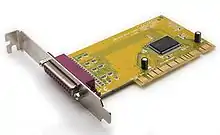Legacy port
In computing, a legacy port is a computer port or connector that is considered by some to be fully or partially superseded.[1] The replacement ports usually provide most of the functionality of the legacy ports with higher speeds, more compact design, or plug and play and hot swap capabilities for greater ease of use. Modern PC motherboards use separate Super I/O controllers to provide legacy ports, since current chipsets do not offer direct support for them. A category of computers called legacy-free PCs omits these ports, typically retaining only USB for external expansion.

A parallel port implemented as a PCI card. Users can use expansion cards to add deprecated legacy ports to newer computer systems that do not provide them.
USB adapters are often used to provide legacy ports if they are required on systems not equipped with them.
Common legacy ports
| Legacy port | Typical uses | Commonly replaced by |
|---|---|---|
| Centronics parallel port | Printer,[2] scanner, removable media | USB, Wi-Fi, Ethernet |
| External parallel SCSI | Removable media | USB, Thunderbolt, Serial Attached SCSI |
| AT connector / DIN | Keyboard | USB |
| Serial port / RS-232 | console, modem, mouse[2] | USB |
| PS/2 connector / 6-pin mini-DIN | keyboard, mouse[2][3][4] | USB |
| Game port / DA-15 | MIDI, gaming devices such as joysticks[2] | USB |
| Apple Desktop Bus / mini-DIN | low speed external peripherals; such as keyboard, mouse, or joystick | USB |
| Localtalk / mini-DIN | OldWorld Macintosh printer and LAN | USB, Wi-Fi, Ethernet |
| Industry Standard Architecture (ISA) bus | Connect peripheral cards to motherboard[2] | PCI Express |
| VGA / DE-15 | display connector[5] | DVI, HDMI, DisplayPort |
| Parallel ATA[6] | Internal hard drives, CD-ROM | Serial ATA, M.2 |
| Floppy drive connector | Floppy drives, tape drives | USB |
| IEEE 1394 (FireWire) | Video devices, external storage | USB 3.0, Thunderbolt |
| Accelerated Graphics Port | Video card | PCI Express |
| PC Card | Laptop storage cards, other peripherals | ExpressCard, USB |
References
- definition of legacy from Oxford Dictionaries Online
- "Archived White Papers". Microsoft.com. Retrieved 2013-12-21.
- Computing (2002-09-17). "Build It: Legacy Free PC". ExtremeTech. Retrieved 2013-12-21.
- Fisco, Richard (2005-03-22). "Top Ten Buying Tips - Desktop PCs: The Essential Consumer Buying Guide". PCMag.com. Retrieved 2013-12-21.
- Archived June 11, 2010, at the Wayback Machine
- "What Is PATA? (with picture)". Wisegeek.com. 2013-12-03. Retrieved 2013-12-21.
This article is issued from Wikipedia. The text is licensed under Creative Commons - Attribution - Sharealike. Additional terms may apply for the media files.